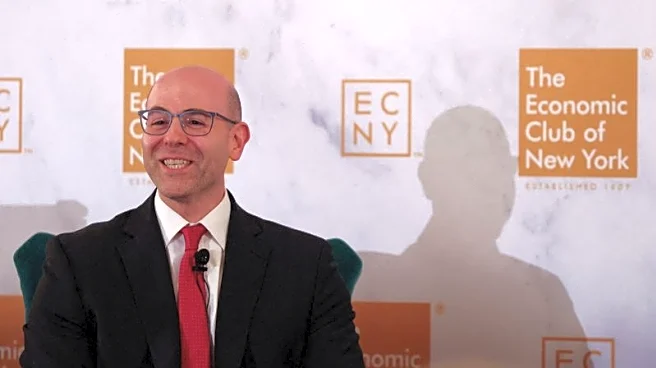What's Happening?
Gold and silver markets experienced a significant reversal following hawkish comments from Federal Reserve officials. Earlier in the week, both metals had surged in a three-day rally, defying expectations of a sideways consolidation. However, the momentum
shifted on Thursday, leading to a sharp decline by Friday. The reversal was influenced by the Federal Reserve's comments, which dampened expectations for a December rate cut. The CME's FedWatch Tool now indicates only a 49% probability of a quarter-point cut in December, a notable shift from earlier optimism. This potential rate cut would be the third reduction this year. Additionally, the reopening of the U.S. government after a 43-day shutdown revealed deteriorating labor market conditions, further impacting market sentiment.
Why It's Important?
The shift in market sentiment has broader implications for investors and the economy. The Federal Reserve's stance on interest rates is crucial for financial markets, influencing investment strategies and economic forecasts. A rate cut typically supports asset prices, including precious metals, by lowering borrowing costs and encouraging investment. However, the reduced likelihood of a December cut suggests continued uncertainty in the economic outlook, particularly concerning inflation and labor market stability. Investors who had positioned for a bullish trend in gold and silver may need to reassess their strategies in light of these developments. The market's reaction underscores the sensitivity of asset prices to monetary policy signals and economic data releases.
What's Next?
Market participants will closely monitor upcoming economic data and Federal Reserve communications for further indications of monetary policy direction. The probability of a rate cut in December remains uncertain, and any new data on inflation or employment could sway expectations. Investors may also look for signs of stabilization in the labor market, which could influence the Federal Reserve's decision-making process. Additionally, the reopening of the government may lead to the release of delayed economic reports, providing more clarity on the current economic conditions. Stakeholders, including financial analysts and policymakers, will need to navigate these uncertainties as they plan for the remainder of the year.
Beyond the Headlines
The recent developments highlight the complex interplay between government actions, economic indicators, and market expectations. The reopening of the government after a prolonged shutdown has brought attention to the impact of political decisions on economic data flows and market stability. Furthermore, the Federal Reserve's cautious approach reflects broader concerns about inflation and employment, which are critical factors in shaping monetary policy. As markets react to these dynamics, investors must consider both short-term fluctuations and long-term structural drivers in their decision-making processes.














